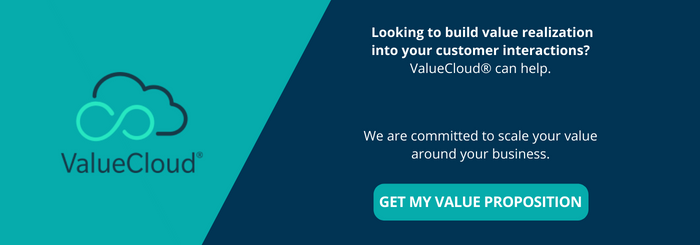How to Communicate Your UVP in a Way That Matters to Your Customers

For today’s marketers, the top two pillars of copywriting are to know your audience and focus on benefits. This philosophy also applies to sales. In general, customers are more responsive to sales pitches when they understand how your product or service will meet their needs. Your customers need to understand what you offer and why you’re better than your competitors.
This is why you should be intimately familiar with your unique customer proposition (UVP), also often known as customer value proposition (CVP), and how to frame it for different customer groups. Each potential client will react differently to your pitch based on their personality, so it’s important to switch up your approach. Your UVP won’t change, but your pitches should be based on the individual customer. By learning how to communicate your value proposition to each prospect or current client, you increase your chances of connecting with them and helping them realize your value.
What is a Value Proposition?
Your unique value proposition is built on how your product or service appeals to a certain type of customer. Your UVP might also include traits that appeal to potential employees.
Refining your UVP for different customer groups lets you target your audience with more precision. For example, let’s say you run a shipping company. While your commercial clients might prioritize efficiency and volume, your individual customers might be more concerned about how their packages are handled.
Your unique value proposition might be that your speedy deliveries are always handled with care, but your customer value proposition will be tailored to address the concerns of each market segment you’re targeting.
How to Develop Your Unique Value Proposition
Here is a quick refresher on how to develop your UVP. Start by answering these questions:
- What is your product or service?
- Who are the target customers for your product or service?
- How does it benefit these target customers?
- What makes you stand out from the competition?
Use these answers to create a short headline that’s easy to understand. Your headline should be free of jargon, and it should be exciting enough to inspire customers to read your value proposition. Next, write a sub-headline that details what you offer, who you offer it to, and why it’s useful. Next, create a bulleted list outlining what differentiates you from your competitors.
These bullets should be specific. As you go, you can start identifying different customer segments and what they value about your product or service. List out their specific problems and how your product or service addresses these problems for each customer group. Knowing why customers choose you over another company will help you create sales pitches tailored to new prospects.
Look through existing customer feedback and reviews, or conduct a client survey to better understand why your customers choose your product or service. Listen carefully to what they say, because understanding your customers’ needs is key to creating a UVP that resonates.
Using Your UVP to Tailor Sales Pitches
Now that you’re familiar with your UVP, you can start using it to tailor sales pitches to each unique customer group. Whether you’re a B2B business pitching to buyers within a company or you’re a B2C business, your buyers will usually fall into one of these customer personality types:
- Analytical
- Assertive
- Amiable
- Expressive
- Spontaneous
- Skeptical
Each type has a different approach to their purchasing decisions. Here are some pointers on how to approach different types of potential customers.
Analytical
This type of customer is most receptive to data-driven sales pitches. When communicating your UVP to analytical types, focus on case studies and real-world results. Analytical customers want to be sure that you can deliver on your promises. An analytical person will likely come to the sales pitch with plenty of questions. Make sure you’re prepared to answer them. Do your homework first and know your UVP forward and backward.
Assertive
Assertive customers are driven and likely to be more controlling than some of your other customers. To appeal to the assertive prospects on your list, be prepared. Don’t spend a lot of time explaining details about your company and its mission. Instead, focus on how you can benefit these customers and back up your claims with statistics. Assertive customers tend to make quick decisions, so don’t bore them with unnecessary details.
Amiable
People who are amiable are often friendly and laid back, and they value team harmony. For this reason, they might not make decisions as quickly as an assertive customer. Selling to this customer requires a customer focus. Focus on their needs and how you can help them add value to their organization. Amiable people are usually risk-averse. Appeal to them with a money-back guarantee, a trial period, or a clear refund policy.
Expressive
This customer is more creative than other types. They are also typically more concerned about other people. In a B2B relationship, expressive customers will want to know how your product or service is going to affect everyone else on their team.
When pitching to an expressive person, outline how you’ll maintain the relationship. Expressive people value connection. They want to know they can count on you if they have a problem at any time during the sales cycle. Focus on the customer-service parts of your UVP.
Spontaneous
A spontaneous customer will likely be quick to make a decision.
Regardless of your primary customer focus, you need to be excited about your company. Be enthusiastic about your UVP and appeal to these customers with information that is most relevant to their needs. Spice up your sales pitch so it captures this customer’s attention and makes them excited to buy from you.
You might be able to hook a spontaneous buyer up front. Perfect your live chat skills, and prep your product demo videos in case they want to know more before you can meet in person.
Skeptical
The skeptical customer is likely to be one of your harder sells. This customer probably won’t trust you right away and may ask targeted questions to understand your product fully. You’ll need to have a thorough understanding of your product and UVP .
You might offer a trial period, so make sure you are attentive and meet their needs. Counteract their skepticism by delivering on your promises.
Determining the Customer’s Personality
When you’ve been in sales for a while, you are usually able to assess a customer’s personality quickly. But if you’re new to the game or if sales isn’t your strength, pay close attention during your initial prospecting call. Make note of how many questions they ask, along with the types of questions they’re asking. Are they focused on their overall team? Are they concerned with specific metrics?
Consider how engaged they are during your call. An expressive person might be engaged for the first few minutes of your call and then drop off if you’re not keeping them interested. An assertive person might be short with you, demanding that you get to the point. If you’re still not sure, come to the meeting prepared for any personality type and let the customer guide you through the sales meeting.
How to Appeal to Individual Motivators
You don’t need to change your UVP to fit the customer. You should know what you offer to each and every prospect. But knowing the type of customer before your sales meeting will help you decide which parts of your UVP to highlight.
If you’ve conducted an initial call to establish the customer’s needs and prepare your sales pitch, you might have an idea of your buyer’s personality. This will help you narrow your pitch to meet their specific needs and potential objections.
If you know that you’re going into a meeting with an analytical or skeptical person, give them more time to ask questions. Don’t make up answers off the top of your head. Be as detailed as possible. If you don’t have an answer ready, tell them you’ll look into it and then follow up.
Don’t Do It Alone
Writing your UVP lets you effectively compete with others in your market. Knowing what makes you stand out and being able to communicate them to customers will help you differentiate yourself from your competition. Having a thorough understanding of your UVP and with the different types of customers you may encounter helps you craft a more effective sales pitch.
DecisionLink has a solution to help you automate this process. Our ValueCloud® can help you simplify and automate these conversations, making it easier for your whole sales team to communicate your UVP to different types of customers. Use this tool to refine your benefits-based sales pitches.
Customer Example:
Planview economic impact: 16% Increase in ASP enterprise deals
93% Increase in ASP strategic deals
Read the full case study to learn how Planview's UVP helped close more deals and increase deal size.

 ValueCloud
ValueCloud
.png?width=118&height=76&name=Rectangle%20(3).png) ValueCloud Ignite
ValueCloud Ignite
.png?width=92&height=92&name=Rectangle%20(4).png) Free Assessment
Free Assessment
.png?width=100&height=100&name=Rectangle%20(5).png) Watch a Demo
Watch a Demo
.png?width=82&height=96&name=Rectangle%20(6).png) Value Calculator
Value Calculator

.png?width=62&height=51&name=Group%2010%20(1).png) Marketing
Marketing
 Sales
Sales
 Customer Success
Customer Success
 Engage Prospects
Engage Prospects
 Win Deals Faster
Win Deals Faster
 Retain Customers
Retain Customers
.png?width=62&height=62&name=Rectangle%20(8).png) Adopt and Scale
Adopt and Scale
.png?width=54&height=54&name=Rectangle%20(9).png) Cybersecurity
Cybersecurity
 Healthcare
Healthcare
.png?width=54&height=54&name=Rectangle%20(10).png) IT & Software
IT & Software




